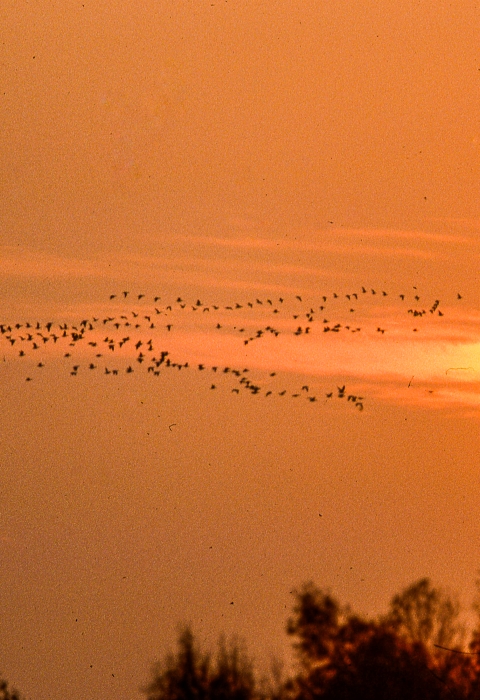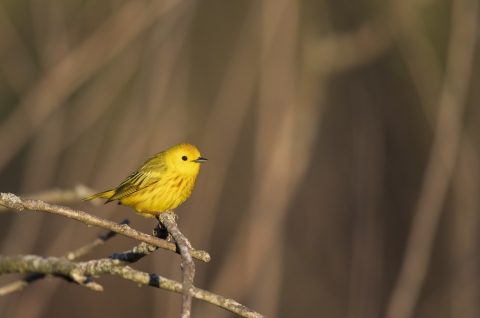If you’re an avid birder, nature lover or even just enjoy going for a stroll near your home, you’d probably be thrilled to see a yellow warbler whiz by or hear its cheerful “sweet, sweet, sugary sweet” song ring through the trees. While many of us enjoy wildlife encounters like these, the experience isn’t the same for everyone.
Generally, birders and ornithologists rely on calls and songs to identify birds just as much as they use their sight. But for deaf or hard of hearing birders, birding by sound can be difficult, or even impossible.
Using sight for song
Retired U.S. Fish and Wildlife Service biologist Ron Popowski — who is deaf — developed a life hack for birding while working in northern Arizona with his U.S. Forest Service colleague Hans — who is hearing — in the 1990s.
When Hans heard a bird vocalize, he tipped off Ron with a series of hand signals and motions — a combination of American Sign Language and their own invented code. With his knowledge of ecosystems and bird behavior, Ron was able to deduce the general habitat and locate a bird for a species-specific identification.
For example, when Hans heard a “tap, tap, tap, tap” in the woods, he’d signal “woodpecker” to Ron. With this clue, Ron could then determine the general habitat, height and possible direction to visually locate the woodpecker. From there, he’d identify the species — a yellow-bellied sapsucker.
Ron and Hans used this silent code to record bird species in the Coconino National Forest, as part of a broader baseline data collection. This way, Ron could perform his work duties and enjoy the same challenge that comes with identifying birds instead of simply being told what they were. Together, they identified birds such as Clark’s nutcracker, doves, poorwill, warblers, wrens, sandhill crane, northern goshawk and Mexican spotted owl.
Birding for all
Even if you aren’t a biologist who is deaf or hard of hearing, Ron’s method or similar techniques can be useful for birders of all abilities.
The last thing you want to do on an early-morning birding outing is scare away a bird by saying (maybe even shouting, eek!) to your friend who’s dragging behind, “Look for the wood thrush.” Gesturing and signing is a covert way to share information.
Or you might flip to a page in a field guide and point out the speculated species you heard. This also works as a nice strategy for being inclusive among a group of people who speak different languages.
Some techniques — like using bird-song phonetic spellings called mnemonics — can assist hearing as well as deaf and hard-of-hearing birders alike with remembering and identifying songbirds. To some, the red-eyed vireo may sound like “look up, over here, see me, up here.” Assigning words to notes can help distinguish sounds.
These are a few of our favorites, or you can make up your own!
- "chick-a-dee-dee-dee" - Black-capped chickadee
- "peter, peter, peter" - Tufted titmouse
- "tea kettle, tea kettle, tea kettle" - Carolina wren
- "drink-your-tea" - Eastern towhee
- "cheer up, cheerily, cheerily" - American robin
Pickin’ up good vibrations!
Programmed to pick up rustling leaves, babbling brooks, frog calls or bird songs, vibration-alert devices are fun tools to experience nature through another sensory channel. These clever gadgets detect the sounds of nature and translate them into meaningful vibrations the user can feel, enhancing their outdoor experience.
Additional tools are available for those with high-register hearing loss or presbycusis. As most birds sing in higher registers, assistive devices that lower the pitch of their songs without slowing them down allow birders to detect the pattern and rhythm in an audible register. Some advanced smartphone applications, like Merlin from the Cornell Lab of Ornithology, can record bird songs and suggest matching species while visually showing the pattern of song.
It’s helpful to remember that everyone’s needs and experiences are different — and often, being inclusive improves the experience for everyone! We are always looking for more tips and tricks that can be useful for enjoying the outdoors. Next time you’re participating in your favorite hobby, consider how you can ensure its accessible to everyone.






